Fetal Surgery for Spina Bifida: Elliana's Story
Published on
Published on
Nicole couldn't have been happier the day an ultrasound confirmed her intuition that she was carrying a girl. But a call from her obstetrician two days later had her questioning whether she would ever get to meet her daughter. The scan revealed abnormalities in her unborn baby's brain and head shape.
 "It was the best day ever followed by the worst day ever," Nicole remembers. Her doctor referred her to a maternal-fetal medicine specialist, who discovered an opening in the baby's spinal cord. It was myelomeningocele - the most serious form of spina bifida. Spina bifida is a birth defect in which an area of the spinal column doesn't form properly, leaving a section of the spinal cord and spinal nerves exposed.
"It was the best day ever followed by the worst day ever," Nicole remembers. Her doctor referred her to a maternal-fetal medicine specialist, who discovered an opening in the baby's spinal cord. It was myelomeningocele - the most serious form of spina bifida. Spina bifida is a birth defect in which an area of the spinal column doesn't form properly, leaving a section of the spinal cord and spinal nerves exposed.
The specialist gave her three options: terminate the pregnancy, be assessed for fetal surgery at the Richard D. Wood Jr. Center for Fetal Diagnosis and Treatment at Children's Hospital of Philadelphia (CHOP), or surgically repair the opening after the baby is born.
Nicole was determined to give her baby the best life possible. She had read about the Management of Myelomeningocele Study (MOMS) study, which showed that fetal surgery for spina bifida greatly reduces the need to divert fluid from the brain, improves mobility, and improves the chances that a child will be able to walk independently. The national study was co-led by the Richard D. Wood Jr. Center for Fetal Diagnosis and Treatment (CFDT). There was no question in Nicole's mind: She told the doctor she wanted to go to CHOP.
Less than three weeks later, Nicole left her home and job in Michigan and drove 12 hours to Philadelphia. It wasn't until she walked into the waiting room of the Richard D. Wood Jr. Center for Fetal Diagnosis and Treatment that the enormity of the situation hit her.
"When we first drove into Philly, I was calm and collected and level-headed - until I walked into the CFDT waiting room," she remembers. "That's when the emotions really hit me."
Nicole spent two days undergoing detailed evaluations. She learned that she was eligible for fetal surgery, which must be performed between 19 and 25 weeks' gestation. The baby's lesion was located at L4-5 in the spine and the leakage of cerebrospinal fluid had caused the brainstem to move down into the spinal canal, a condition called hindbrain herniation. This can cause hydrocephalus, which can injure the developing brain. All of these factors contributed to making Nicole and her baby candidates for prenatal repair of spina bifida.
Two days later, Nicole went into surgery. Fetal surgeon Alan W. Flake, MD, FACS, FAAP, operated on Nicole while pediatric neurosurgeon Gregory Heuer, MD, PhD, repaired the opening in the baby's back.
Nicole spent four days recovering in the Hospital before being released to the home of a local family participating in Hosts for Hospitals where she stayed on strict bed rest. She was readmitted with bleeding and contractions two weeks after the surgery. Six days later, with the contractions under control, Nicole settled in to the Ronald McDonald House just around the corner from CHOP to wait out the rest of her pregnancy.
The plan was to deliver the baby by C-section at the Garbose Family Special Delivery Unit (SDU) - the world's first birth facility in a pediatric hospital specifically designed for mothers carrying babies with known birth defects - at 38 weeks' gestation. But three weeks before her scheduled C-section, Nicole woke up in the morning with regular contractions. The decision was made to deliver the baby immediately.
Elliana arrived weighing 5 pounds, 10 ounces. Nicole got to hold her daughter briefly before she was brought to the Newborn/Infant Intensive Care Unit (N/IICU). The results of the fetal surgery were evident: Elliana's hindbrain herniation had completely reversed; there was no clubbing of her feet, as is often the case with babies born with spina bifida; and she could wiggle her toes. Elliana spent 25 days in the N/IICU for issues related to her premature birth - she did not require any special care for the spina bifida.
 Now 6 months old and back home in Michigan, Elliana is "probably the happiest little girl ever," her mother says. "She's always smiling and laughing. She's a people magnet. Everyone wants to see her and talk to her and hold her everywhere I go."
Now 6 months old and back home in Michigan, Elliana is "probably the happiest little girl ever," her mother says. "She's always smiling and laughing. She's a people magnet. Everyone wants to see her and talk to her and hold her everywhere I go."
Elliana receives weekly early-intervention therapy to combat any cognitive and developmental days caused by the brain abnormalities discovered before birth. But so far, Nicole doesn't notice any differences between her daughter and other babies her age.
Elliana shows signs of possible muscle weakness in her right foot, but she loves to stand on her mother's lap and bounce her legs. She was recently diagnosed with neurogenic bowel and bladder, but so far, it's looking like she will not need a shunt to drain fluid from her ventricles.
"She's doing amazing," Nicole says. "She is a true miracle."
Published March 2018